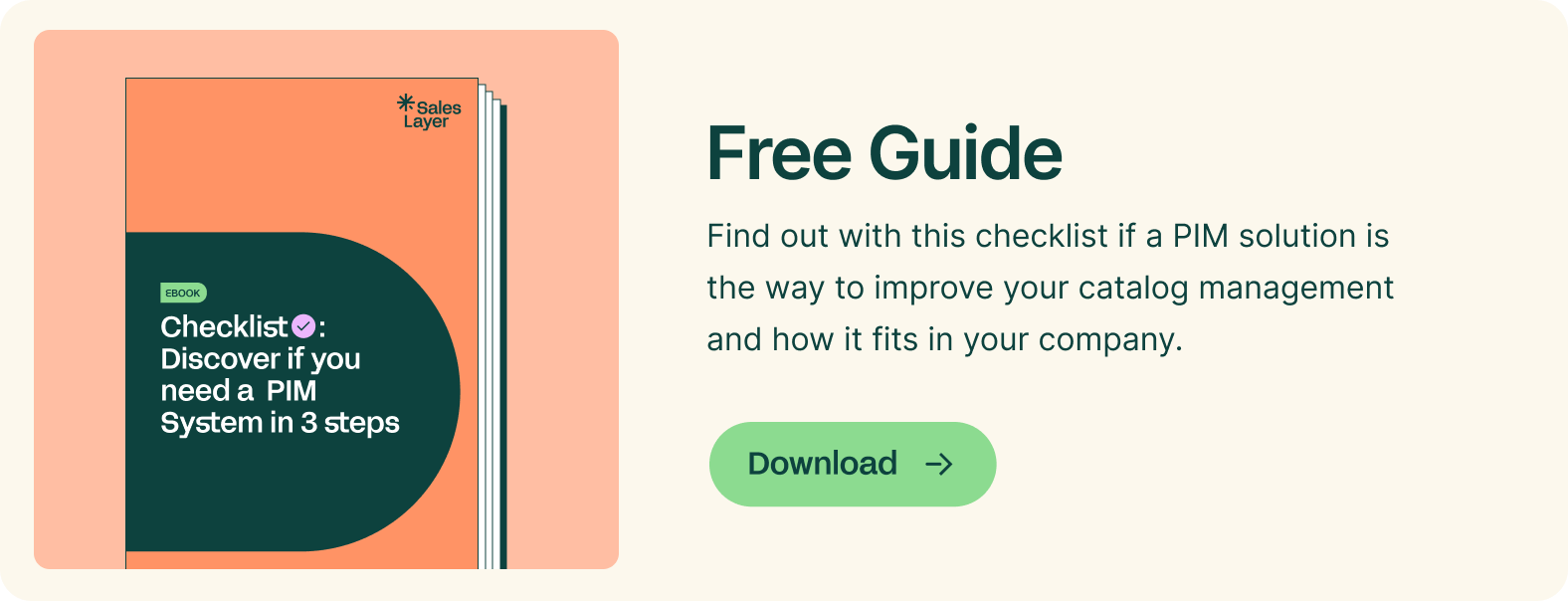
What is product information management?
Product information management (PIM) is the technology and process enabling organizations to manage their product data. It is a central repository for all relevant product information such as product names, descriptions, pricing, images, and more. This information can then be syndicated to multiple channels, such as e-commerce websites, product pages, print catalogs, marketplaces, and even social media.
Think of PIM (Product Information Management) as the platform for gathering, syndicating, editing, and sharing product information.
PIM is a vital system for the buying experience. Manufacturers and retailers must manage a growing number of sources and outputs for product data—e-commerce platforms, marketplaces, catalog design teams, developers and IT teams, distributors, suppliers, analysts, product descriptions, and many more.
With a PIM solution, any company can:
- Centralize all its product data
- Manage product data more quickly
- Save costs and time
- Gain flexibility in modifying and connecting product information to any person or place
What is product experience management?
Product Experience Management (PXM) seeks to adapt and optimize product content to each channel based on the users’ needs. It is a fundamental process that analyzes all decisions and resources that impact the product experience and improve customer satisfaction. The need for a smooth customer experience is the primary reason why 98% of marketers believe that personalization is key in advancing customer relationships.
PXM is a strategic process that focuses on offering users the best possible product image. The foundation of a solid multi-channel strategy, PXM is no longer just about customer satisfaction based on product quality; it is about adapting your products to each platform and presenting them to each buyer in the most effective way.
An effective PXM strategy involves:
- Generating the correct product data that meets the user’s needs
- Collecting and distributing products efficiently across multiple platforms used by the customer
- Constantly adapting it to fit the customers’ evolving needs
Implementing a solid PXM strategy requires systems like PIM to generate higher engagement, increase sales, and create a seamless customer journey for your target audience.
Benefits of Using PIM for PXM
One of the most significant benefits of using a Product Information Management system for your product experiences is that it makes managing all your product information—from product descriptions to images and videos—so much easier.
Thanks to this system, you can ensure consistency across all aspects of your products, including branding and messaging, which will help create a better overall experience for your customers.
PIM systems can also help you save time and money by automating tasks such as product data entry and enrichment, which would otherwise be very time-consuming tasks.
Other essential features of a PIM for Product Experience Management include the ability to organize internal workflows in your team, keep an activity history, and back up your data.
Sales Layer’s PIM system for Product Experience Management will help you create a more seamless and enjoyable experience for your customers through its PXM solutions.
1. Enhance the customer experience
PIM and PXM are two essential components of any e-commerce operation. By using PIM to manage product information and PXM to manage the customer experience, businesses can ensure that their customers have a positive experience with their products from start to finish.
Using PIM for PXM leads to several key benefits for businesses and customers. It helps ensure that products are consistently represented across all sales channels, including online stores, product packaging, marketing materials, CRM, and more. This consistency enables customers to quickly find the information they need about a product and feel confident in their purchasing decisions.
PIM also allows businesses to manage customer reviews and product ratings, further enhancing the customer experience. By monitoring and responding to customer feedback, companies can show that they value their customers' input and are constantly working to improve their products.
Using PIM for PXM leads to a better customer experience by helping businesses provide accurate and consistent product information, manage customer feedback, and continually improve their products. As a result, companies can boost customer satisfaction, loyalty, and retention.
2. Simplified experience for retailers and other industries
Companies can more easily optimize and implement effective product content management by centralizing and standardizing product data across their various systems and channels. This leads to faster time-to-market and increased sales, and strengthened customer relationships, as retailers and other industries are better able to provide a unified and consistent product experience and digital assets across all their channels.
Additionally, with PIM for PXM, companies can more easily maintain and update their product information, ensuring that customers always have access to the most up-to-date and accurate product content.
By leveraging PIM for PXM, retailers and other industries can streamline product management processes and deliver an enhanced customer experience.
3. Irreplaceable tool for MDM
Master Data Management (MDM) is a process for the collection, syndication, and management of an organization's critical business data—from legal, financial, and human resources documentation to product, commercial network, customer databases, and other supply chain elements such as product providers, customers, etc.
PIM is a branch of the MDM management process, the key to delivering high-quality product content in all marketing, sales, and omnichannel actions.
MDM tends to be a costly technology system and can lack product content expertise. Complementing MDM with a PIM system is essential for manufacturers and retailers.
PIM systems help businesses effectively manage their product data and critical business data, ensuring that they are accurate, complete, and consistent across all channels. They also provide a crucial foundation for product experience management (PXM), which helps businesses deliver a consistent, positive experience to customers across all touchpoints.
Additionally, PIM for PXM enables businesses to optimize their product offerings, identifying new opportunities for growth and ensuring that they are consistently delivering the best possible customer experience.
4. Personalization
One of the primary benefits of using product information management for PXM is creating personalized experiences for customers.
Through PIM, businesses can gather and organize data about their products and customers, enabling them to tailor their marketing efforts and promotional materials based on shoppers' specific needs.
For example, by understanding which product features are most important to a particular customer segment, a company can create targeted messages that emphasize features. This customized approach leads to improved customer satisfaction, loyalty and increased sales.
The customized connections that a PIM system allows can also send catalog data to any platform such as a website, mobile app, Amazon or Google Manufacturer marketplaces, catalog/brochure design and printing software, etc.
In today's competitive marketplace, the ability to personalize the customer experience is a crucial differentiator for businesses. Those who leverage PIM to its fullest potential will be well-positioned to win the battle for customer mindshare.
5. Contextualization
Product data stored in a PIM system includes rich metadata that describes products in detail. This data can create a detailed customer profile that captures product preferences, browsing and purchase history, and other critical information. This contextual data enables marketers to deliver personalized experiences at every touchpoint along the customer journey.
For example, a retailer might use PIM data to personalize product recommendations on their e-commerce site based on customers' past purchases. A manufacturer can also use PIM data to target customer service reminders based on their products.
PIM-powered contextualization leads to deeper customer insights and more relevant, personalized experiences. As a result, organizations that use PIM to power their PXM strategy are better able to meet the needs of their customers and drive business growth.
6. Automation and optimization through AI and ML
Product information management (PIM) and product experience management (PXM) are two essential—but often overlooked—aspects of e-commerce. PIM is the process of managing product data, while PXM manages the customer's experience with that product. Too often, businesses focus on one or the other to the detriment of their overall e-commerce strategy.
However, by leveraging PIM for PXM, businesses can take advantage of the benefits of automation and optimization through artificial intelligence (AI) and machine learning (ML).
Businesses can gather and analyze product data at scale to better understand customer needs and preferences through these technologies. They are empowered to create more personalized and targeted product recommendations, optimize search and navigation experiences, and drive more effective marketing campaigns.
Using PIM for PXM is a powerful tool for businesses looking to gain a competitive edge in the e-commerce landscape. Whether you are looking to understand your customers better or improve your product offerings, harnessing the power of AI and ML can help you reach your goals.
Sales Layer is the best PIM solution for PXM
As e-commerce continues to grow and take over consumers’ shopping experiences, businesses need to take their product information and experience management to the next level.
PIM and PXM are two sides of the same coin—you need both to implement an effective e-commerce strategy.
At Sales Layer, we offer a comprehensive PIM system that can integrate your existing PXM platform and strategies. Sales Layer PIM is designed to help you get the most out of your customer data to provide them with a personalized shopping experience that they won't forget.
Contact us today for a free trial and see how our solution can help you take your e-commerce business to greater heights.








